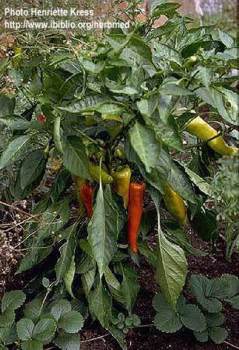Crops
Capsicum annum L. var. longum (DC) Sendt. - Hot Pepper
Taxonomy.
Family Solanaceae Juss., genus Capsicum L.Biology and morphology.
2n=24. Perennial, grassy plant cultivated as annual. Root system is a tap root. The stalk is 4-5-hedral, 20-125 cm tall, grassy, in process of growth becomes coarse and woody. Monopodial branching before formation of the first flower, then simpodial. Leaves smooth-edged, ovate to lanceolate, light to dark green in color, long leafstalks, single or collected into a rosette. Flowers form where the stalk branches. Flower bi-sexual with 5-sided corolla, white, yellow or violet in color. Facultative self-pollinator (isolation is necessary in order to avoid cross-pollination). Fruit is a false hollow berry, polyspermous, 2-4-camerare, of various forms (mainly conical) and colors. Length 0.8-20 cm; diameter 1-5 cm; thickness of fruit walls 1-10 mm; weight 5-200 g. Fruits drooping, stricted. Seeds on placenta, located at the basis of fruit, light yellow, flat or slightly curved. 150-200 seeds has a mass of 1 g. There are three subspecies: large-fruited, small-fruited, and wild-growing. Large-fruited varieties can have trunk, long- and short-conical, and finger shapes. Very hot sorts can have short-finger shape: Shipka, Astrakhanskij 60 (Transcaucasia, Middle Asia, Far East). Middle-ripening varieties: Astrakhanskij 147 (Lower and Middle Volga, Stavropol region, Ukraine, Kazakhstan), Astrakhan 628 (Middle Chernozem Region, southern Russia), Dzhambul'skij mestnyi, Kutaisuri (Georgia), Slonovyi khobot 304 (Georgia, Azerbaijan), Ukrainskij gor'kij (Ukraine, Moldova). Late-ripening variety: Marelanskij 330 (Uzbekistan, Kazakhstan).Distribution.
Capsicum annum occurs in Central and South America as a wild plant. It began to be cultivated about 6 thousand years ago. It was introduced into Russia in the 16th century. Plantations cover about 62 thousand hectares of the former USSR. Cultivated mainly in Middle Asia, the Caucasus, Ukraine, and Kazakhstan. Plantations in Moldova, southern Russia, and the Far East. Species used in amateur cultivations in more northern regions.Ecology.
Requires more heat than sweet pepper. Optimum temperature for growth is 28-29°C (22-24 in the Nonchernozem zone). Growth stops at 13°C. It does not withstand frosts. Plant requires short days (14 hours). Photophilous. The vegetative period lasts 175-190 days. Prefers light, rich soil. Does not like salty, heavy, clay, cold, sour soil (optimum pH is 6-6.6).Economic value.
Fruits contain alkaloid capsaicin (about 0.2%), which results in a bitter taste, and essential oils (0.1-1.25%). Pepper used as a spice and as a medicine for treating rheumatism and stomach deseases. Insecticide. Ornamental plant. Productivity is 12 tons per hectare or more.References.
Gazenbush, V.L. 1958. Pepper - Capsicum Tourn.//Cultural flora of the USSR. V. 20 Vegetable nightshade family. Ed. by D.D.Brezhnev. Moscow-Leningrad. pp 394-487.Hrenova, V.V. 1981. Pepper and eggplants. Moscow.
Vehov, V.N., Gubanov, I.A., Lebedeva, G.F. 1978. Cultural plants of the USSR. Moscow.
Zhuleva, V.M., Cherenok, L.G. 2002. Tomatoes, pepper, eggplants, ground cherry. Moscow.


